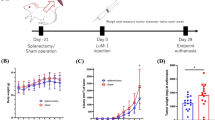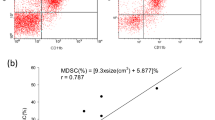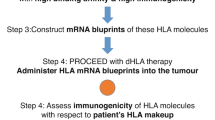Abstract
(A x CBA(T6)F1 mice bearing F1 mammary carcinomas for 9 days were injected i.v. with A strain spleen cells. The A spleen cells were from either non-immune donors or mice which had received an i.p. injection of F1 tumours cells 9 days previously, and were thus immune to the CBA component of the tumour. Fourteen days after receiving parental spleen cells, the F1-tumour-bearing mice were killed and their spleen ratios and indices were determined as an index of the severity of the graft-versus-host reaction (GvHR) induced. The spleen indices were compared with those in non-tumour-bearing F1 mice, receiving aliquots of the same parental cell suspensions. At the higher doses of A spleen cells, the presence of an F1 tumour reduced the GvHR. At the same time, in 3/5 experiments, the weight of the F1 tumour in mice injected with immune A spleen cells was less than that in F1 mice receiving the same number of tumour cells but no spleen cells. A reduction in GvHR and a decrease in tumour weight was not seen when F1 mice carrying an A strain tumour were injected with A strain spleen cells immune to an F1 tumour. Adding 23-day F1 tumour-bearing F1 spleen cells to A spleen cells did not reduce the GvHR induced in further non-tumour-bearing F1 recipients by the parental cells. This was evidence against the presence of suppressor cells in the tumour-bearing F1 spleen. When 51Cr-labelled A strain spleen cells were injected into F1 mice, some of which had a tumour and therefore an enlarged spleen, there was an inverse relation between the size of the spleen and the number of parental cells therein, per g spleen 4 h after injection. It is thus suggested that the reduction in GvHR in F1-tumour-bearing F1 mice, after injection of parental spleen cells, is due first to a reduction in the concentration of donor cells in the recipient spleen (i.e. the same number of donor cells in a larger spleen) and second to pre-occupation of the donor cells in reacting to the tumour.
This is a preview of subscription content, access via your institution
Access options
Subscribe to this journal
Receive 24 print issues and online access
$259.00 per year
only $10.79 per issue
Buy this article
- Purchase on Springer Link
- Instant access to full article PDF
Prices may be subject to local taxes which are calculated during checkout
Similar content being viewed by others
Rights and permissions
About this article
Cite this article
Whitmarsh-Everiss, T., Symes, M. The presence of a tumour in F1 mice partially inhibits the GvH reaction following injection of parental spleen cells. Br J Cancer 43, 305–311 (1981). https://doi.org/10.1038/bjc.1981.48
Issue Date:
DOI: https://doi.org/10.1038/bjc.1981.48



